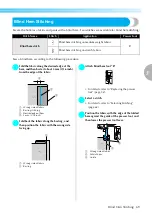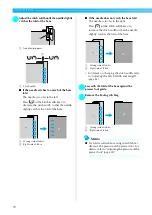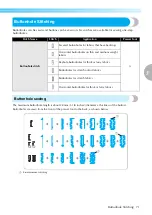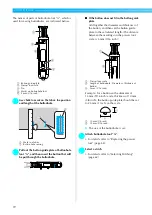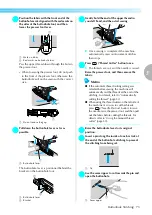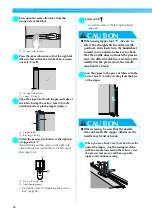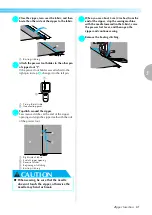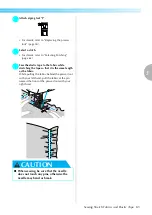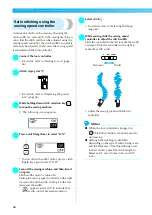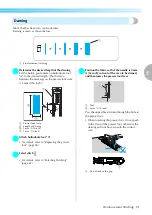
Zipper Insertion
79
3
—— — — — — — — — — — — — — — — — — — — — — — — — — — — — — — — — — — — — — — — — — — — — — — — — — — — —
e
Attach the presser foot holder to the right pin
of zipper foot “I”.
a
Pin on the right side
b
Needle drop point
• For details, refer to “Replacing the presser
foot” (page 38).
f
Select stitch .
• For details, refer to “Selecting Stitching”
(page 62).
CAUTION
g
Topstitch around the zipper.
a
Stitching
b
Right side of fabric
c
Basting stitching
d
End of zipper opening
CAUTION
h
Remove the basting stitching.
Inserting a side zipper
Stitching is sewn on only one piece of fabric. Use this
type of zipper application for side openings and back
openings.
a
Stitching
b
Right side of fabric
c
End of zipper opening
The following procedure will describe how to stitch
on the left side, as shown in the illustration.
a
Attach zigzag foot “J” and sew straight stitches
up to the zipper opening.
With the right sides of the fabric facing each
other, sew reverse stitches after reaching the
zipper opening.
• For details, refer to “Basic stitching” (page
67).
b
Using a basting stitch, continue sewing to the
edge of the fabric.
a
Basting stitching
b
Reverse stitches
c
Wrong side of fabric
d
End of zipper opening
●
When using zipper foot “I”, be sure to
select the straight stitch (center needle
position), and slowly turn the handwheel
toward you (counterclockwise) to check
that the needle does not touch the presser
foot. If a different stitch is selected or the
needle hits the presser foot, the needle
may bend or break.
2
1
I
1
2
3
4
●
When sewing, be sure that the needle
does not touch the zipper, otherwise the
needle may bend or break.
1
2
3
1
2
3
4
Summary of Contents for 885-U26
Page 2: ......
Page 16: ...14 ...
Page 62: ...SEWING BASICS 60 ...
Page 122: ......
Page 123: ......





